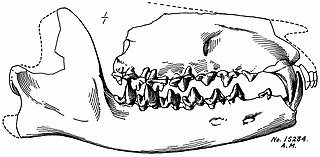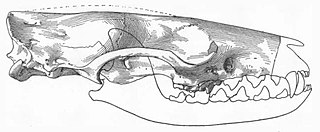Related Research Articles

Gastornis is an extinct genus of large flightless birds that lived during the mid-Paleocene to mid-Eocene epochs of the Paleogene period. Fossils have been found in Europe, Asia and North America, with the remains from North America originally assigned to the genus Diatryma.

Hyaenodon ("hyena-tooth") is an extinct genus of carnivorous placental mammals from extinct tribe Hyaenodontini within extinct subfamily Hyaenodontinae, that lived in Eurasia and North America from the middle Eocene, throughout the Oligocene, to the early Miocene.

Miacis is an extinct genus of placental mammals from clade Carnivoraformes, that lived in North America from early to middle Eocene.

Palaearctonyx is an extinct genus of omnivorous placental mammals from clade Carnivoraformes, that lived in North America from early to middle Eocene.

Vassacyon is an extinct genus of placental mammals from clade Carnivoraformes, that lived in North America and Europe from the late Paleocene to early Eocene. It is considered the largest of the early Eocene mammals.
Xinyuictis is an extinct genus of placental mammals from clade Carnivoraformes, that lived in Asia from early to late Eocene.

Didymictis is an extinct genus of placental mammals from extinct subfamily Didymictinae within extinct family Viverravidae, that lived in North America and Europe from the late Paleocene to middle Eocene.

Tritemnodon was an extinct genus of placental mammals from extinct order Hyaenodonta, that lived in North America during the early Eocene. Fossils of Tritemnodon agilis have been found in Utah and Wyoming. It was the size of a wolf.

Tillodontia is an extinct suborder of eutherian mammals known from the Early Paleocene to Late Eocene of China, the Late Paleocene to Middle Eocene of North America where they display their maximum species diversity, the Middle Eocene of Pakistan, and the Early Eocene of Europe. Leaving no descendants, they are most closely related to the pantodonts, another extinct group. The tillodonts were medium- to large-sized animals that probably feed on roots and tubers in temperate to subtropical habitats.

Sinopa is an extinct genus of placental mammals from extinct family Sinopidae within extinct order Hyaenodonta, that lived in North America and Asia from the early to middle Eocene.

Palaeonictis is an extinct genus of placental mammals from extinct subfamily Palaeonictinae within extinct family Oxyaenidae, that lived in Europe and North America from the late Paleocene to the early Eocene.
The Willwood Formation is a sedimentary sequence deposited during the late Paleocene to early Eocene, or Clarkforkian, Wasatchian and Bridgerian in the NALMA classification.
The Lignites de Soissonais is a geologic formation in the Var, Marne departments of France. It preserves fossils dating back to the Ypresian stage of the Eocene period.

Galecyon ("polecat-dog") is an extinct genus of placental mammals from extinct order Hyaenodonta, that lived in Europe and North America during the early Eocene.

Limnocyon is an extinct paraphyletic genus of limnocyonid hyaenodonts that lived in North America during the middle Eocene. Fossils of this animal have been found in California, Utah and Wyoming.

Pyrocyon is an extinct genus of small carnivorous placental mammals from extinct order Hyaenodonta, that lived in North America during the early Eocene. Fossils of Pyrocyon have been found in Wyoming and Colorado. Weight of Pyrocyon dioctetus has been estimated at around 2.6 kilograms.

Prolimnocyon is an extinct paraphyletic genus of limnocyonid hyaenodonts that lived in Asia and North America during the late Paleocene to middle Eocene. Prolimnocyon chowi is the earliest known member of the hyaenodontid family Limnocyonidae.

Viverravus is an extinct genus of placental mammals from extinct subfamily Viverravinae within extinct family Viverravidae, that lived in North America, Europe and Asia from the middle Paleocene to middle Eocene.
Wyonycteris is a genus of small mammals that existed in the late Paleocene and early Eocene epochs. The type species is Wyonycteris chalix, which lived in Wyoming during the Clarkforkian North American Land Mammal Age of the Paleocene and was originally proposed to be an early form of insectivorous bat. Later re-examination of the material has put this alliance in doubt, and the genus has instead been proposed as belonging to the subfamily Placentidentinae, within the family Nyctitheriidae. Similar fossil material of the same time period found in Europe was later discovered and described as new species, Wyonycteris richardi.

Proviverridae is an extinct family of placental mammals from extinct superfamily Hyaenodontoidea within extinct order Hyaenodonta. Fossil remains of these mammals are known from early to late Eocene deposits in Europe.
References
- ↑ D. E. Russell and M. Godinot. 1988. The Paroxyclaenidae (Mammalia) and a new form from the early Eocene of Palette, France. Paläontologische Zeitschrift 62(3/4):319-331
- ↑ Floréal Solé; Olivia Plateau; Kévin Le Verger; Alain Phélizon (2019). New paroxyclaenid mammals from the early Eocene of the Paris Basin (France) shed light on the origin and evolution of these endemic European cimolestans. Journal of Systematic Palaeontology Online edition. doi : 10.1080/14772019.2018.1551248.


